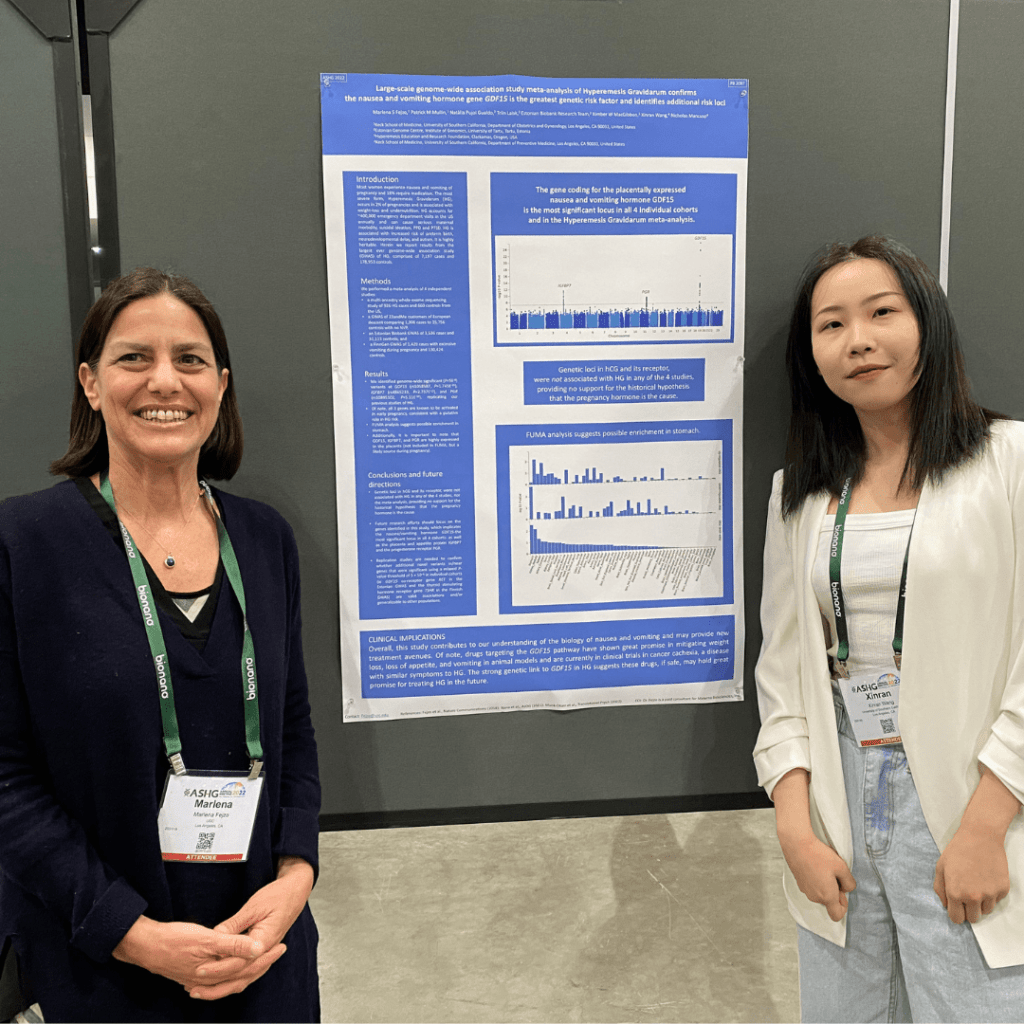
Dr. Fejzo presented our team’s results from the largest ever genetic study of HG (7,197 HG cases and 178,953 controls) at the American Society of Human Genetics annual conference in Los Angeles on October 26, 2022. She showed genetic evidence that the nausea and vomiting hormone is the most likely cause of HG in 4 separate populations across the globe. The gene coding for the placenta and appetite hormone GDF15, produced at high levels by the placenta during pregnancy, was the most significant locus in all 4 studies. Genes coding for other placental factors including the progesterone receptor and the insulin-like growth factor-binding protein 7, were also implicated.
Abstract
Large-scale genome-wide association study meta-analysis of Hyperemesis Gravidarum confirms the nausea and vomiting hormone gene GDF15 is the greatest genetic risk factor and identifies additional risk loci
Marlena S Fejzo,1 Patrick M Mullin,1 Natàlia Pujol Gualdo,2 Triin Laisk,2 Estonian Biobank Research Team, Kimber W MacGibbon,3 Xinran Wang,4 Nicholas Mancuso4
1Keck School of Medicine, University of Southern California, Department of Obstetrics and Gynecology, Los Angeles, CA 90033, United States
2 Estonian Genome Centre, Institute of Genomics, University of Tartu, Tartu, Estonia
3 Hyperemesis Education and Research Foundation, Clackamas, Oregon, USA
4Keck School of Medicine, University of Southern California, Department of Preventive Medicine, Los Angeles, CA 90033, United States
Most women experience nausea and vomiting of pregnancy and 18% require medication. The most severe form, Hyperemesis Gravidarum (HG), occurs in 2% of pregnancies and is associated with weight-loss and undernutrition. HG accounts for ~400,000 emergency department visits in the US annually and can cause serious maternal morbidity, suicidal ideation and PTSD. HG is associated with increased risk of preterm birth, neurodevelopmental delay, and autism. It is highly heritable. Herein we report results from the largest ever genome-wide association study (GWAS) of HG, comprised of 7,197 cases and 178,953 controls.
We performed a meta-analysis of 4 independent studies: a multi-ancestry whole-exome sequencing study of 926 HG cases and 660 controls from the US, a GWAS of 23andMe customers of European descent comparing 1,306 cases to 15,756 controls with no NVP, an Estonian Biobank GWAS of 3,536 cases and 32,113 controls, and a FinnGen GWAS of 1,429 cases with excessive vomiting during pregnancy and 130,424 controls. We identified genome-wide significant (P<5E-8) variants at GDF15 (rs1058587, P=1.745E-26), IGFBP7 (rs4865233, P=2.737E-12), and PGR (rs10895102, P=5.11E-10), replicating our previous studies of HG. Of note, all 3 genes are known to be activated in early pregnancy, consistent with a putative role in HG risk. FUMA analysis suggests possible enrichment in stomach.
Genetic loci in hCG and its receptor, were not associated with HG in any of the 4 studies, nor the meta-analysis, providing no support for the historical hypothesis that the pregnancy hormone is the cause. Future research efforts should focus on the genes identified in this study, which implicates the nausea/vomiting hormone GDF15-the most significant locus in all 4 cohorts- as well as the placenta and appetite protein IGFBP7 and the progesterone receptor PGR. Replication studies are needed to confirm whether additional novel variants in/near genes that were significant using a relaxed P-value threshold of 5 × 10−6 in individual cohorts (ie GDF15 co-receptor gene RET in the Estonian GWAS and the thyroid stimulating hormone receptor gene TSHR in the Finnish GWAS) are valid associations and/or generalizable to other populations.
Overall, this study contributes to our understanding of the biology of nausea and vomiting and may provide new treatment avenues. Of note, drugs targeting the GDF15 pathway have shown great promise in mitigating weight loss, loss of appetite, and vomiting in animal models and are currently in clinical trials in cancer cachexia, a disease with similar symptoms to HG. The strong link to this pathway in HG suggests these drugs, if safe, may hold great promise for treating HG in the future.
GET INVOLVED
- Participate in HG research.
- Become an advocate.
- Make a gift to the HER Foundation.
- Share your story and support other HG moms.
- Become a HER Foundation volunteer.
- Blog about HG and show support for HER.
- Share resources with local health professionals and hospitals.
©2022 HER Foundation. All rights reserved.

